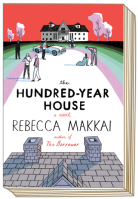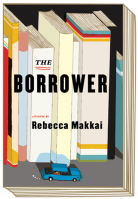 “We’ve been blessed with some crappy weather, which is really nice.”
“We’ve been blessed with some crappy weather, which is really nice.”
For a writer who counts among her greatest fears giving a reading to which only one person—her ex—shows up, it turns out that crappy weather is a blessing in disguise.
About the East Coast events during her current book tour, author Rebecca Makkai says that, “They’re going really well. Most of them have been kind of extraordinary turnouts. You never know what kind of turnout you’re going to get in the summer. If it’s really nice, no one comes because it’s summer.”
 Makkai is spending much of this summer promoting her latest novel, The Hundred-Year House. From Maine, New York, and Vermont to Arkansas, Colorado, and Minnesota, Makkai will be greeting readers and fans across the country. Of course, she’ll also be making a number of stops in Chicagoland, which she calls home.
Makkai is spending much of this summer promoting her latest novel, The Hundred-Year House. From Maine, New York, and Vermont to Arkansas, Colorado, and Minnesota, Makkai will be greeting readers and fans across the country. Of course, she’ll also be making a number of stops in Chicagoland, which she calls home.
The Hundred-Year House hit bookstore shelves earlier this month, to rave reviews. The novel centers around a couple living in a hundred-year-old estate north of Chicago, a house which once served as an artists’ colony. The story travels among 1929, 1955, and 1999 as the history—and mystery—of the house and its inhabitants unfolds. Early praise for the book describes Makkai’s writing with myriad positive terms, among them “expert,” “clever,” “lyrical,” “hilarious,” “heartbreaking,” “absorbing,” “spirited,” and “delicious.”
This effusive acclaim comes on the heels of the glowing reviews for Makkai’s debut novel, The Borrower (Viking, 2011), which Wendy Smith in the Chicago Tribune praised, noting that “Makkai’s probing novel reminds us that literature matters because it helps us discover ourselves while exploring the worlds of others.”
Makkai herself has been exploring some new worlds: The publication of her novels has opened to her the world of publishing. And, although publishing her first novel left Makkai thrilled but terrified—a new experience that thrust her into the world of writers and editors and publishers and booksellers—the publication of her sophomore effort has left her thrilled and relatively relaxed. Relatively.
“This time I’ve had a better idea of what to expect, and I enjoy it. I can revel in this moment,” she says. “Everything’s been very exciting.”
Part of that ability to revel in the moment might well come from Makkai’s conviction that The Hundred-Year House is a stronger story than The Borrower—which was almost universally praised. But even so, Makki seems more confident about her second offering. “I really strongly believe that this is a better book than my first one,” Makkai says. “It’s a richer, more ambitious book.”
That doesn’t mean that there’s no pressure, however, with this sophomore effort. Expectations are a little higher. The measuring stick is a little taller. The fan base is a little bigger. But all of that has added up to something wonderful. “The really amazing thing about the second book is that people are looking for it,” Makkai says, a tinge of awe in her voice. “With this book, there were a lot of people who were looking forward to it, who asked me when it was coming out.”
 Although she might have had a smaller fan base and she might have been something of a publishing outsider before the publication of The Borrower, Makkai is now in the thick of this new world with legions of fans and followers, reviewers and critics. And she didn’t even have to leave town to get there.
Although she might have had a smaller fan base and she might have been something of a publishing outsider before the publication of The Borrower, Makkai is now in the thick of this new world with legions of fans and followers, reviewers and critics. And she didn’t even have to leave town to get there.
A Chicagoland girl born and bred, Makkai has spent most of her 36 years in the city’s suburbs, in Edgewater, and in the city proper. Her upbringing and her experiences here have shaped her work, and they play a big role in her latest novel. The Hundred-Year House, for example, not only is set in the area but “Chicago is very much a presence in it,” Makkai says, as is the culture of the North Shore, including its wealthy neighbors, its baronial estates, its coach houses, and its artists’ colonies.
Chicago has lent Makkai not only fodder for her novels but also a place to call home and a supportive community of cohorts and colleagues. “It’s an endless city,” she says. “But it’s small enough that there is cohesion in the literary community.”
That community is now one to which Makkai fully belongs. And it’s one that she’s liking quite a bit. “There’s something really cool about the way the Chicago press supports Chicago writers,” Makkai says. “I think there are enough major writers here, too, where people now see Chicago as a literary hot spot.”
Chicago is certainly a literary hot spot for Makkai. Not only does she live here, not only does she write here, not only are her books set here, but she also teaches here (at Lake Forest College and StoryStudio Chicago). And that’s not all: She promotes her books here, too; Makkai will be reading and signing and chatting about her books at a number of locations in the city and suburbs during the next several weeks. It’s something of a virtuous circle, and it’s one that Makkai is pretty pleased about.
“I really can’t see living anywhere else,” she says. “It’s a perfect place to be a writer.”
—Kelli Christiansen
Rebecca Makkai is the author of, most recently, The Hundred-Year House as well as the novel The Borrower. Her short fiction has been anthologized in The Best American Short Stories 2011, 2010, 2009 and 2008; The Best American Nonrequired Reading 2009; New Stories from the Midwest; and Best, American Fantasy.






